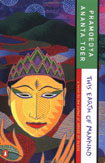This article has multiple issues. Please help improve it or discuss these issues on the talk page. (Learn how and when to remove these messages)
|
 Book cover | |
| Author | Pramoedya Ananta Toer |
|---|---|
| Original title | Bumi Manusia |
| Translator | Maxwell Ronald Lane (English) |
| Language | Indonesian trans. to English |
| Series | Buru Quartet |
| Genre | Historical novel |
| Publisher | Hasta Mitra |
Publication date | 1980 |
| Publication place | Indonesia |
| Followed by | Child of All Nations |
This Earth of Mankind is the first book in Pramoedya Ananta Toer's epic quartet called Buru Quartet, first published by Hasta Mitra in 1980. The story is set at the end of the Dutch colonial rule and was written while Pramoedya was imprisoned on the political island prison of Buru in eastern Indonesia. The story was first narrated verbally to Pramoedya's fellow prisoners in 1973 because he did not get permission to write.[1] The story spread through all the inmates until 1975 when Pramoedya was finally granted permission to write the detailed story.
The central character and the narrator of This Earth of Mankind is a Javanese boy, Minke, who is fortunate to attend an elite Dutch school because he is a descendant of Javanese royalty (the character is based on Tirto Adhi Soerjo). Minke faces a complex and dangerous world when he meets Nyai Ontosoroh, a njai or concubine of a Dutch man. Minke's life becomes more dangerous when he falls in love with Annelies, the beautiful Indo daughter of Nyai Ontosoroh. In This Earth of Mankind, Pramoedya portrayed the unjust life of the Indonesian people during the Dutch colonization period when social status was governed by the amount of European blood running through their veins. Pramoedya characterized Minke as an outspoken person, who refuses this hierarchical society by becoming a writer instead of a speech-maker, which bears a resemblance to Pramoedya's life who was jailed for two years after carrying anti-Dutch documents and then became a writer.[1]
The Indonesian Attorney General banned This Earth of Mankind in 1981.[2] Many copies of the first editions survived and circulated, along with editions published in Malaysia. It was returned to print in Indonesia in 2005 by the publisher Lentera Depantara, after it had already appeared worldwide in 33 languages.
- ^ a b "Author Interview". Penguin Reading Guides on This Earth of Mankind. Penguin Group. Retrieved 8 May 2007.
- ^ Alit Ambara (27 March 2010). "Banned book". Indonesian Institute of Social History. Retrieved 17 April 2014.